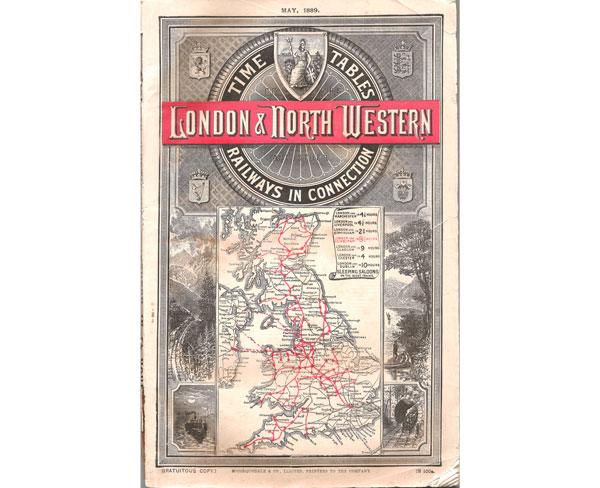Description
Paper covers, 11.5”x 7.25”, 135pp. Note this download does not include the folding maps which are too fragile to scan. Outside of a museum or library, it is rare to find intact copies of 19th century timetables. Printed on cheap quality paper, with a designed lifespan of a month, the paper becomes brittle with age and exposure to light. Scanning can be quite difficult, because the thin paper causes the imprint of letterpress on the revere side to show through and the tiny fonts used for footnotes can be difficult to read. However these can be viewed with reasonable clarity at “1:1”. How much more attractive timetable covers were in those days compared to the present!
The LNWR helped itself to the image of Britannia as a kind of trade mark at an early stage of its history. The lions of England and Scotland, the Prince of Wales feathers and a harp show the countries served by the railway, while attractive little vignettes of wild scenery and an angler tempt the jaded city dweller to head for Wales or Scotland. A dramatically moonlit paddle steamer indicates the availability of night services to the Emerald Isle. A scroll gives the shortest journey times between London and various cities, and it is noteworthy that the London and Edinburgh time of eight and a half hours is highlighted in red, reflecting the outcome of the “racing” to the Scottish capital between the LNWR, its Scottish ally the Caledonian, and the East Coast companies the previous year.
The publication is full of fascinating detail; for example, this is prior to the introduction of corridor trains, so on board catering is in its infancy. Passengers using dining saloons were there for the duration of the journey. Only two trains per day each way between London and Manchester, and two each way between London and Liverpool (for the Atlantic Liner trade) offered this facility. There were no such vehicles on Anglo Scottish services, where passengers had to pre-book hot lunches to be consumed during a brief stop at Crewe, Rugby or Stafford, otherwise they could pre-book a cold luncheon basket to consume on the train. There does not appear to have been any similar arrangement for dinner.
In 1886, the trains may not have been as fast, or as frequent as today (it is amazing to see how sparse the service was on what we would now regard as important routes) but the range of facilities available, including private saloons for the equivalent of four first and three third class fares, and through bookings from provincial stations to most of Europe and the near east demonstrate that not everything changes for the better.
PREVIEW BELOW – MAY TAKE A WHILE TO LOAD. If you can´t see the preview, please click here.

Reviews
There are no reviews yet.